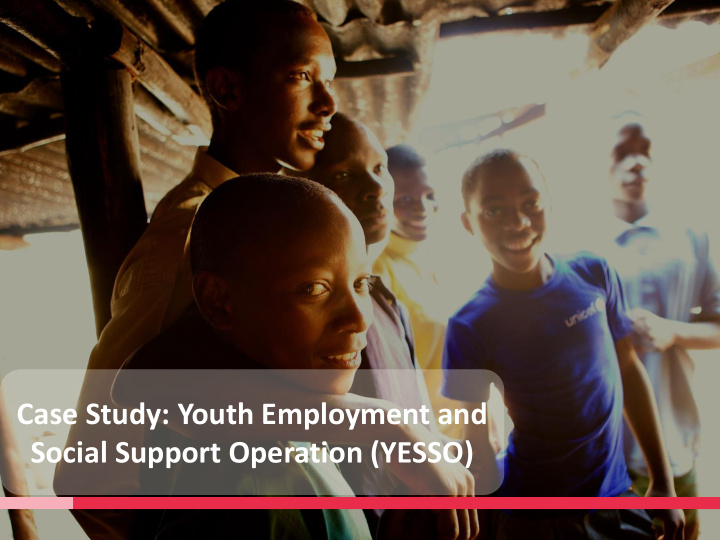



Case Study: Youth Employment and Social Support Operation (YESSO)
Youth Employment and Social Support Operation (YESSO) Team Members Overall Objective 1. Gabriel Wilhelm Sule “To Increase Access of the 2. Douglas Opio Poor to Youth Employment 3. Kate Williams Opportunities, Social Services and Strengthened 4. Abubakar Atiku Musa Safety Net System in 5. Roselyn Wangui Gakure Participating States” Resource Person: Drew Gardiner
Background Nigeria faces youth unemployment & youth restiveness challenges: • 51% of Nigerian population are young (NBS 2011) • National youth unemployment is 37% • 70% of unemployed youth are uneducated and unskilled and most of the educated youths are unemployed • 2/3 rd of population has a primary or less than a primary education. • Infant, child and maternal mortality rates as well as malnutrition rates, remain very high. YESSO is a support operation that is out to reduce poverty by creating: • Immediate employment opportunities through (Public Work Fare & Skill for Job) for the teeming youths and; • Conditional Cash Transfers
Youth Employment and Social Support Operation (YESSO) Component 3: Skills for Job Program Component 1: Public Works Fare Component 2: Conditional Cash Transfers
Theory of Change: Skills for Job Program Need Assessment Need Assessment Intervention Intervention National Level Assumptions: Project Level Assumptions: • Enough job offers by private sector business Operators to • State funds are available to pay participants stipends absorb the graduating participants into the labour before being reimbursed 75% IDA Fund. market. Assumptions • Graduated students utilize starter packs to start their own • Private sector are willing to hire youth . business rather than selling them to others . • Absence of corruption practices . Youth Youth have entrepreneurial skills Youth have have Provision access to Youth have vocational Intermediary access to of Starter job outcomes / technical skills career Packs placement orientatio Youth have life skills services n training Youth apply skills and access information relevant to labour-market Youth are sufficiently employed (waged & self-employment) Outcomes 5
Research Questions Research Question 1: Do trainings and job placement support lead to jobs for Nigerian youth? Research Question 2: Do youth who participate in trainings and job placement support have a decreased propensity to engage in negative social and risk taking behaviours? Research Question 3: Do the public-private partnership arrangements improve the quality of youth’s work experience?
Phase-in cluster design Intervention 1 National Poverty Register x 18 LGAs 20 States 360 LGAs 180 treatment 180 control Poverty Poverty Poverty Poverty Poverty Poverty segment segment segment segment segment segment 2000 2000 2000 2000 2000 2000 youth youth youth youth youth youth Intervention 2
Timeline 2015 2016 2017 1st quarter 2nd quarter 3rd quarter 4th quarter 1st quarter 2nd quarter 3rd quarter 4th quarter 1st quarter 2nd quarter 3rd quarter 4th quarter Jan Feb Mar April May Jun Jul Aug Sep Oct Nov Dec Jan Feb Mar April May Jun Jul Aug Sep Oct Nov Dec Jan Feb Mar April May Jun Jul Aug Sep Oct Nov Dec Activity Identification of sample Baseline Randomisation Intervention: - Career orientation (1 month) - Training ( 6 months) - Starter pack - Internship (6 months) Follow-up survey Intervention 2
Power Calculation (Optimal Design Software)
Data and Sample Size Source of Data: Administrative & Survey Indicators to be measured: # of youth participants who have jobs 1 year after completing trainings and job placement Significance Level: 0.05 Standardized Effect Size: 0.15 Sample: 360 Significance Level: 0.05 Standardized Effect Size: 0.10 Sample: 550 ICC: 0.17 Assumption: based on evaluation (Diaz and Jaramillo 2006) of ProJoven youth employment program from Peru, employment effect of between 7-18%
Potential Challenges Challenges : 1. Attrition: Interstate movement of participant 2. Attrition due to frustration: Drop out of the control group before the end line survey 3. Drop out: Some youth many abandon the programme overtime Solutions: 1. Tracking the respondents using administrative and biometric data 2. Phase in approach will be used to keep the control group engaged 3. Bigger sample size and revise the power calculation if necessary
Results • Why and to whom the result would be useful? • Policy makers: Guide resource allocation and long term policy strategy • Legislators: To influence enactment of law that would create an Agency that would effectively coordinate , monitor and report results of all Social Protection interventions • Youth : Inform career choices • Development partners : Identification of projects to fund • Dissemination : • Stakeholder meetings and electronic and print media. • Executive council meeting through supervising Minister
Recommend
More recommend